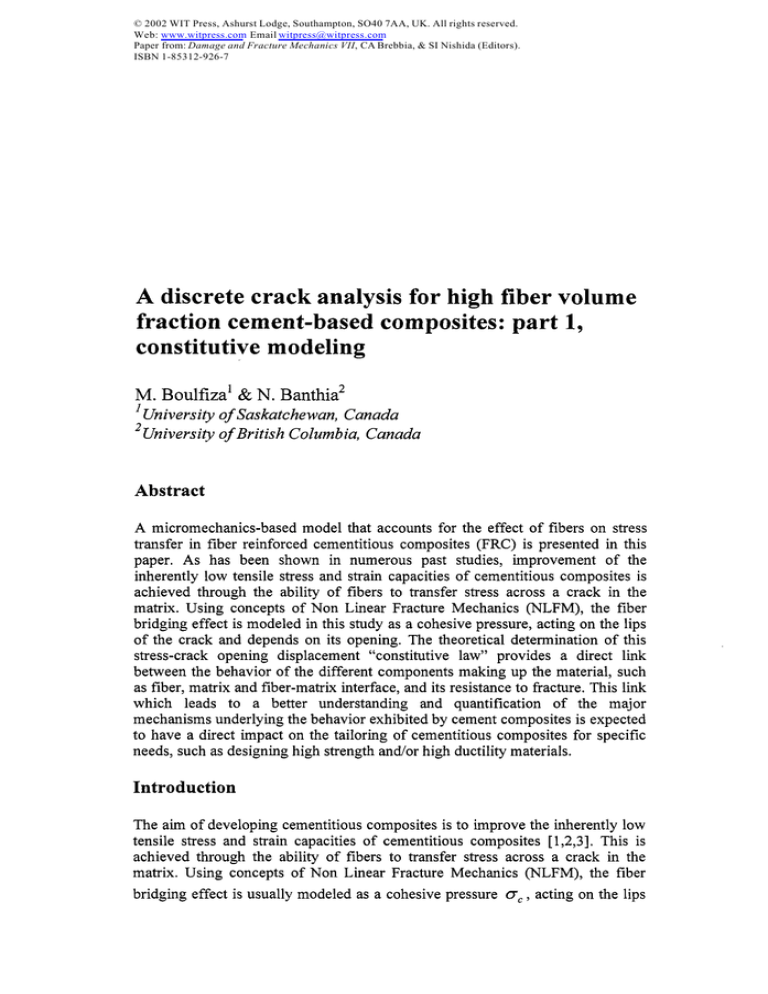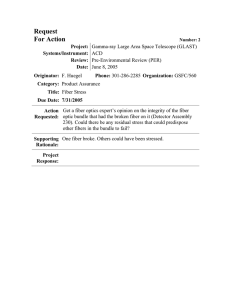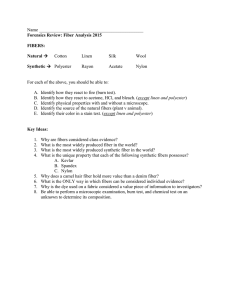
© 2002 WIT Press, Ashurst Lodge, Southampton, SO40 7AA, UK. All rights reserved.
Web: www.witpress.com Email witpress@witpress.com
Paper from: Damage and Fracture Mechanics VII, CA Brebbia, & SI Nishida (Editors).
ISBN 1-85312-926-7
A discrete crack analysis for high fiber volume
fraction cement-based composites: part 1,
constitutive modeling
M. Boulfizal &N, Banthia2
1University of Saskatchewan, Canada
2University of British Columbia, Canada
Abstract
A micromechanics-based model that accounts for the effect of fibers on stress
transfer in fiber reinforced cementitious composites (FRC) is presented in this
paper. As has been shown in numerous past studies, improvement of the
inherently low tensile stress and strain capacities of cementitious composites is
achieved through the ability of fibers to transfer stress across a crack in the
matrix. Using concepts of Non Linear Fracture Mechanics (NLFM), the fiber
bridging effect is modeled in this study as a cohesive pressure, acting on the lips
of the crack and depends on its opening. The theoretical determination of this
stress-crack opening displacement “constitutive law” provides a direct link
between the behavior of the different components making up the material, such
as fiber, matrix and fiber-matrix interface, and its resistance to fracture. This link
which leads to a better understanding and quantification of the major
mechanisms underlying the behavior exhibited by cement composites is expected
to have a direct impact on the tailoring of cementitious composites for specific
needs, such as designing high strength and/or high ductility materials.
Introduction
The aim of developing cementitious composites is to improve the inherently low
tensile stress and strain capacities of cementitious composites [1,2,3], This is
achieved through the ability of fibers to transfer stress across a crack in the
matrix. Using concepts of Non Linear Fracture Mechanics (NLFM), the fiber
bridging effect is usually modeled as a cohesive pressure OC, acting on the lips
© 2002 WIT Press, Ashurst Lodge, Southampton, SO40 7AA, UK. All rights reserved.
Web: www.witpress.com Email witpress@witpress.com
Paper from: Damage and Fracture Mechanics VII, CA Brebbia, & SI Nishida (Editors).
ISBN 1-85312-926-7
43 fj Damageand Fracture Mechanics VII
of the crack and depending on its opening 6C. This stress-crack opening
displacement “constitutive law” could be determined either experimentally or
theoretically [5]. The major advantage of a theoretical determination of the
cohesive pressure, resides in the link it provides between the behavior of the
different components making up the material, such as fiber, matrix and fibermatrix interface, and its resistance to fracture. This link which leads to a better
understanding and quantification of the major mechanisms underlying the
behavior exhibited by cement composites should allow the tailoring of
cementitious composites for specific needs, such as designing high strength
and/or high ductility materials.
A micromechanics-based cohesive pressure is proposed to account for the
effect of fibers on the fracture behavior of FRC materials. Unlike most models in
the litera~~e, this model assumes that cracking plays a major role in the FRC’S
behavior right from departure from linearity, In the case of low fiber volume
fractions, this reduces to the usual assumption that the peak load behavior is
controlled by a crack whose opening and propagation will eventually lead to the
failure of the structural element. In case of high fiber volume ffaction, however,
a strain hardening zone where multiple cracking takes place is displayed by the
composite prior to peak load, At this stage of loading it becomes easier to create
a new crack than to open an existing one. In the proposed model we assume that
the overall behavior of an elementary volume element around a material point
containing a certain number of microcracks could be reproduced by lumping into
an “equivalent” cohesive pressure the effects of multiple microcrack creation,
propagation, and interaction, The rule of mixtures is assumed to hold true for the
linear behavior of the composite,
2 Micromechanical
modeling
Due to the different nature of fracturing mechanisms in the pre and post peak
regimes, the cohesive pressure development has been divided into two
successive stages; a strain hardening zone followed by a strain softening zone,
2.1 Strain hardening zone
The following assumptions are made for the strain hardening regime starting at
frost departure from linearity up to peak load:
a- Fibers have a 3D random distribution in location and orientation
b- Fibers are straight with cylindrical geometry
c- Fibers behavior: linear elastic
d- Fiber ruptures when its ultimate strength is reached
e- Matrix crack is planar
f- Fiber-Matrix bond:
elastic prior to debonding
frictional shear in the debonded area
g-
Average embedment length is Lf / 4 ( Lf denotes the fiber length).
© 2002 WIT Press, Ashurst Lodge, Southampton, SO40 7AA, UK. All rights reserved.
Web: www.witpress.com Email witpress@witpress.com
Paper from: Damage and Fracture Mechanics VII, CA Brebbia, & SI Nishida (Editors).
ISBN 1-85312-926-7
Damage and Fracture Mechanics VII
437
(
>
0
-$+1~
!1
x
Figure 1: Single fiber bridging a matrix crack.
The last assumption implies that the embedment lengths are assumed to be
uniformly distributed between O and Lf /2. At this stage, the model only
predicts the tensile stress-crack opening displacement curve m(w) . No
assumptions regarding matrix bulk properties are made. Some of the above
assumptions hold true only for certain fiber types, while others, at best,
approximate the real behavior. For instance, the model should not be used for
fibers which undergo extensive yielding prior to rupture. For x e [0, Z] in
Figure 1, let us study the fi’eebody diagram shown in Figure 2.
LLL
LLLr
=f
Ci!r
Figure 2: Free body diagram of a fiber embedded in a matrix
Equilibrium of forces together with application of boundary con~itions at
x=landx=O:
1
Vf
C7J=-C7C
CJf
Ef
––~u
at x=1
(1)
atx=O
© 2002 WIT Press, Ashurst Lodge, Southampton, SO40 7AA, UK. All rights reserved.
Web: www.witpress.com Email witpress@witpress.com
Paper from: Damage and Fracture Mechanics VII, CA Brebbia, & SI Nishida (Editors).
ISBN 1-85312-926-7
438
Damage and Fracture Mechanics VII
allows the determination of the debonding length
l–vf Em r 1
1= ——–—
(2)
Vj E2Tm%0
and the elastic strain in the fiber is given by
2
0(3)
&f(~) = --#x –l)rm= +
‘J
Ef Vf
The crack opening, or the relative displacement of the fiber with respect to the
matrix is given by
~=
A
j(w)-%(x))
(4)
o
and can be written under the form
15+
c$=~o
with
(5)
EJvf
and consequently the expression of the stress as a fi,mction of crack opening for
the strain hardening regime is given by
2vj EEf&@
~.
/
(l-vJ)r
(6)
Efl,
2,2 Strain softening zone
2.2.1 Case of a single fiber in the loading direction
Starting from the simple case of a single fiber pull-out, we make use of statistical
density distributions to account for the effect of randomness in fiber length and
orientation on the FRC behavior.
i- Assumptions a to f that have been adopted in the previous model are still
assumed to be valid
ii- Fiber is assumed to be completely debonded at least on the shortest
embedment length
iii- The Ilictional shear bond strength z(~) between the fiber and the matrix is
allowed to vary with the slippage distance,
Assumption iii is made in order to account for phenomena such as fiber surface
abrasion and accumulation of wear debries observed with synthetic fibqrs and/or
breakdown of the cement at the fiber-matrix interface due to the stiffhess and
hardness of the steel fiber [6], The frictional bond is however, assumed to be
constant over the entire embedded length of the fiber. As can be seen in Figure 4:
r(x) = 7[3]
for
x < 1~- &
(inside matrix)
r(x) =
for
x > If -6
(outside matrix)
o
(7)
© 2002 WIT Press, Ashurst Lodge, Southampton, SO40 7AA, UK. All rights reserved.
Web: www.witpress.com Email witpress@witpress.com
Paper from: Damage and Fracture Mechanics VII, CA Brebbia, & SI Nishida (Editors).
ISBN 1-85312-926-7
Figure 3: Schematic representation of a fiber pull out.
BEFORE LOADING :
*
DURING PULL-OUT :
Figure 4: Pull out model of a single fiber bridging a crack.
The x coordinate system is with respect to the undeformed fiber geometry
(prior to slippage) and is attached to the fiber end. Thus, in the pull out process,
the origin x=O, will be moving with the fiber so that it can remain on its end. The
axial force P(x) at a given fiber section is therefore given by
© 2002 WIT Press, Ashurst Lodge, Southampton, SO40 7AA, UK. All rights reserved.
Web: www.witpress.com Email witpress@witpress.com
Paper from: Damage and Fracture Mechanics VII, CA Brebbia, & SI Nishida (Editors).
ISBN 1-85312-926-7
440
Damageand FractureMechanicsVII
x
Z(i$)mdf
(-is
(8)
J
o
where P. is a constant representing the fiber end anchorage effect when fiber
P(X)=
PO+
end slips, In the case, where I’. is neglected, the pull-out force on a fiber with
embedment length If is given by
(9)
= r(d)
z dj (lY – 6)
It is interesting to note that the graphical representation of this equation
would be a straight line only if the shear bond strength ~(d) is assumed to be a
constant during the entire pull-out process. Most previous models in the literature
were based on such an assumption which usually leads to discrepancies with
experimental observations [1,4].
2.2,2 Case of a cracked cementitious composite
Based on the above described fiber pull-out representation, a model is developed
here for approximating the case of stress transfer across a crack in a cementitious
composite containing short and randomly distributed fibers in both location and
orientation. To this end the effects of fiber embedment length and fiber
orientation have to be accounted for.
To take into account the effect of fiber embedment length we assume that
these fibers follow a random uniform distribution given by
P(~f) = ;
with
lJ G[0, ~J/2]
(lo)
This distribution assumes that the fiber embedment lengths are uniforrnely
distributed between O and Lf /2.
Thus, the number of fibers al!l having
embedment lengths lf to lf + dl, bridging across the crack may be calculated
from
dN = Nt p(l~ ) dlj
for
Zy ● [0, Lf/2]
(11)
where N, is the total number of fibers in the matrix of volume ACLJ which
contains fibers bridging the matrix crack plane of area AC.Consequentl~,
N, =
total fiber volume .—=_Lvf
A.Lf v~
volume per fiber
Lf Af
A
‘4f
(12)
© 2002 WIT Press, Ashurst Lodge, Southampton, SO40 7AA, UK. All rights reserved.
Web: www.witpress.com Email witpress@witpress.com
Paper from: Damage and Fracture Mechanics VII, CA Brebbia, & SI Nishida (Editors).
ISBN 1-85312-926-7
Damage and Fracture Mechanics VII
where
Af
441
denotes the fiber cross-sectional area and Vf the fiber volume
fraction, The load transmitted across the crack through all fibers having
embedment lengths If when the slippage distance is equal to d
c$F(lf ,6) = P(ZJ, 0.W
2ACvf
. —P(lf
,d)dlf
Af Lf
Thus the total load transmitted by all fibers bridging the crack is given by
Lf
—.
(13)
8
2J
C5wf
,@
(14)
If=0
Consequently, the total stress transmitted by all fibers across the crack can be
evaluated as a function of d
F(d)
=
Lj ~
—-
2
2 Vf
crc(8)=$=—
, LfAf,
J=o
r(s) z df (lf -6) dlf
(15)
f
or in final form after integration is performed
Vf
(16)
Crc(8) =
r(d) z df [L; –8Lf 6+12 ($2]
4 Af Lf
It is interesting to note that, even in the case where the frictional shear bond
strength ~ is a constant (does not depend on d ), the transfer of stress across a
crack in the composite is not a linear fimction of the crack opening.
In a random distribution of fibers, only a ffaction of the volume of fibers
bridging the crack are actually parallel to the load direction, and many fibers
contributing to enhancing the tensile strain and stress capacities bridge the crack
at an angle with respect to the crack flanks. The probability density fimction,
~(d), corresponding to a 3D random orientation of fibers is given by
(17)
p(o) = sine
This density function is derived by assuming that a fiber or its extension has
an equal likelihood of crossing any point on a hemisphere centered at the point
where the fiber intercepts the crack. The stress transmitted through a fiber with
angle @ with respect to the loading direction is given by
cr(d, e) = 0(8) cos2e
(18)
Thus, the stress transmitted through fibers with orientation O to O+ dO is given
by
(19)
doC(d, 6) = CC(d) COS20 P(6) de
© 2002 WIT Press, Ashurst Lodge, Southampton, SO40 7AA, UK. All rights reserved.
Web: www.witpress.com Email witpress@witpress.com
Paper from: Damage and Fracture Mechanics VII, CA Brebbia, & SI Nishida (Editors).
ISBN 1-85312-926-7
442
Damageand Fracture Mechanics VII
and the total stress transferred across the crack can be obtained as
77/2
C7c(d,e)=
ac(@cos2ep(e)&’
J
o
42
=OC(6)
~Sin$Cos20d6’
o
(20)
which finally leads to
cc (8)=
Vj
12Af Lf
r(d) zdf
df [L; –8Lf
6+12 321
(21)
Figure 5: A fiber bridging a matrix crack at an angle,
The stress-crack opening constitutive law, which has just been derived is
implemented into a finite element code via interface elements in part 2 of this
paper and used to predict the response of pitch-based carbon fiber reinforced
beams.
3 Conclusions
The following conclusions can be drawn:
●
A micromechanics-based Stress-COD “constitutive law” has been proposed
for modeling the behavior of FRC materials,
●
Starting from the point of departure from linearity up to ultimate failure, the
model accounts for both strain hardening and strain softening regimes
displayed by high fiber volume flaction cement composites.
●
Despite its relative simplicity, the model can be used with both low fiber
volume fraction composites as well as high fiber volume composites.
© 2002 WIT Press, Ashurst Lodge, Southampton, SO40 7AA, UK. All rights reserved.
Web: www.witpress.com Email witpress@witpress.com
Paper from: Damage and Fracture Mechanics VII, CA Brebbia, & SI Nishida (Editors).
ISBN 1-85312-926-7
Damage and Fracture Mechanics VII
.
443
Usefulness of the proposed model is demonstrated through numerical
simulations of cohesive crack creation and propagation in part 2 of this
paper.
References
[1] Banthia, N., Bentur, A., & Mufii, A. Fiber Reinforced Concrete: Present
and Future. CSCE 1998.
[2] N. Banthia, et al. Micro-fiber reinforced cement composites. I. Uniaxial
tensile response, Cdn. J. Of Civil Engg, Vol 21, No 6, pp. 999-1011, 1994.
[3] Bentur, A., & Mindess, S. Fibre Reinforced Cementitious Composites,
Elsevier Applied Science, 1990,
[4] Boulfiza, M. Constitutive Modeling of Fiber Reinforced Cement
Composites, Ph.D. Thesis, University of British Columbia, 1998.
[5] Li, V.C., Wang, Y., & Backer, S. A Micromechanical Model of Tension
Softening and Bridging Toughning of Short Random Fiber Reinforced
Brittle Composites, J. Mech. Phys, Solids Vol. 39, N 5, 1991.
[6] Wang, Y., Li, V.C,, & Backer, S. Analysis of Synthetic fiber Pull-out from
a cement matrix, In, Bonding in Cementitious Composites, eds. S. Mindess
and S.P. Shah, Material Research Society, pp. 159-65, Pittsburg 1988.






